KWin
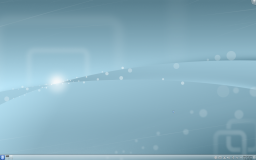 |
El gestor de finestres fiable i flexible per als escriptoris Plasma de KDE, ara amb efectes! |
Descripció general de característiques
- * Estable i fiable.
- * Composició, efectes 3D.
- * Facilitat de configuració.
- * Millora de l'eficiència.
KWin (es pronuncia «KWin») és el gestor de finestres per a l'Escriptori Plasma de KDE. Us dóna un control total sobre les finestres, assegurant-se que no està al mig de les vostres tasques, sinò ajudant-vos amb elles. Pinta la decoració de la finestra, la barra a la part superior de cada finestra (configurable) amb els botons de tancar, maximitzar i minimitzar. També s'ocupa de la col.locació de les finestres i del canvi entre elles.
KWin permet compositing, que consisteix en utilitzar efectes 3D per al maneig de les finestres. Això pot fer la gestió de finestres sidui més suau, més fàcil, més eficient i més natural. Els requeriments de maquinari són molt modestos i gairebé tots els sistemes raonablement moderns des de 2002 són compatibles. Encara hi ha alguns problemes amb algun maquinari, més informació al respecte es pot trobar a techbase.
Característiques pràctiques
Feu clic amb el botó dret del ratolí sobre una decoració de la finestra o utilitzeu Arranjament del sistema per accedir a la nova i fàcil configuració de KWin. Aquí podeu activar efectes per a gestionar més eficientment les finestres. Per exemple, podeu usar Presenta les finestres com l'efecte per al canvi de finestra. En lloc de mostrar les icones o vistes prèvies molt petites de les aplicacions, les disposa en una graella de manera que podreu triar la correcta. Només heu d'utilitzar el seqüència de tecles Alt-Tab i mantenir premuda la tecla Alt. Ara podeu utilitzar el tabulador per a canviar entre les finestres o simplement activar la correcta utilitzant el ratolí. En pressionar les tecles Alt-Tab ràpidament se us mostrarà la finestra següent en la cua, igual que abans.
Si el servidor X és compatible amb «compositing», posar-la en marxa és tan fàcil com obrir Arranjament del sistema, obrint el mòdul , escollir i marcar la caixa de selecció . Configuracions de composició més avançades (com Usa Vsync, Representació directa, Tipus de composició) estan disponibles a través del diàleg . Per a personalitzar el comportament dels efectes de KWin obriu la pestanya , i escolliu quins connectors voleu utilitzar. Si us plau, tingueu en compte que només un subconjunt dels connectors funciona amb la composició basada en XRender. Per a una experiència completa, cal utilitzar el mode OpenGL.
Employing motion physics, KWin provides your windows with a more natural feel. New desktop effects like the Cube desktop switcher and Magic Lamp minimize animation have been added. Improvements in the existing effects make window management smoother than ever. KWin has seen many performance improvements to enable these effects even on low-end hardware. Elaborate checks have been build in to ensure users with low-end hardware are not presented with an unusable setup. KWin detects the capabilities of the hardware and if needed gracefully scales its effects down. You can take control and disable these checks or change settings like the global animation speed to fine-tune your experience. When your computer is under heavy load, KWin will automatically disable the compositing temporarily to keep things running smoothly. It will notify you if it does so, and you can re-enable compositing by pressing Shift+Alt+F12. Finally, support for multiple screen handling has been improved in KWin using the new Kephal library. You can move maximized windows between Xinerama screens and the addition of external screens is handled correctly.
More information about what was introduced in KDE SC 4.2 can be found at the following link:
Tutorials
Voleu que una aplicació es llanci en una mida i posició específiques cada vegada
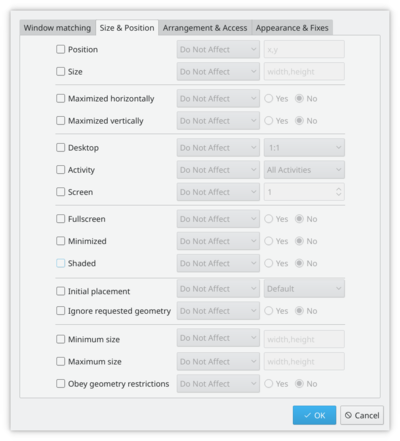
Sometimes the screen position of an application is vital to your comfort, so use the flexibility of KWin to make sure it's always where you want it.
Position the window where you want it to open, then right-click on the title-bar, choosing . This will open a settings window, with appropriate entries already made. All you need to do now is select the tab and check and . OK - you're finished!
Crea un script: El gestor de finestres des de la línia d'ordres
Ús de la utilitat WMIface.
Personalitza la posició dels botons a la barra de títol
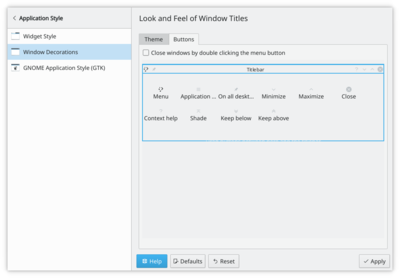
Take a look at tab - and enable . The options open to you may depend on your distribution or theme, and it's clear that there is more to come.
Perhaps you would like more space between the button and the pair? So you will want to add a - two if you wish.
To simply move things around you work with the speciman titlebar - that is the dark blue bar with a large KDE on it. Drag icons there and you will see them move in the preview window at the bottom of the screen.
You may find that you have other icons available to you. A circle indicates that the button will set that window on all desktops. Another icon that you may find useful is Shade - a toggle between rolled up (titlebar only visible) and normal view. These icons are added by dragging from the text description window onto the speciman title bar - just position them as you want to use them.
Si preferiu un clàssic, a l'estil d'escriptori KDE3

|
| Canvi a l'escriptori tradicional |
Right-click on your desktop - select (or , in some distros). Change the from to . The whole desktop is now a folderview, and another right-click on the desktop will allow you to select . Set the folderview to the directory you want to use as your desktop.
Un vídeo de les característiques de KWin
Una demostració de les característiques està aquí
Obrir aplicacions directament en un escriptori diferent
Utilitzeu ordres com:
kstart --desktop 4 kate
Ús amb pantalles petites (per exemple, Netbooks)
Fer més petites la decoració de les finestres
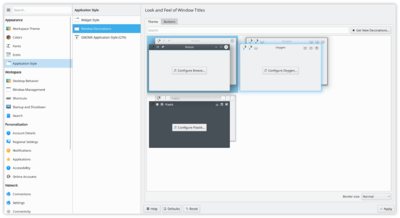
tab. Two good options there:
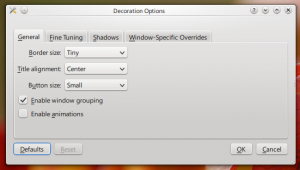
- Using the default style (Oxygen), select and set to and to
- Select the
Both routes will give you slim and functional window titles and borders.
Canvia els tipus de lletra base
On many netbooks the screen is very clear, so that reading fonts much smaller than you expect is feasible. On my Acer Aspire One I find that 8 point is a good base settings.
Fer que Firefox usi estils de lletra més petits
Experimentation with did not bring satisfactory results. Do this instead. Download and install gtk-chtheme from this website. Using that tool you can either set a specific font size, or better still, tell it to use your KDE desktop settings. This will work with Firefox as well as any gtk applications that you use.
Les opcions d'agregació del KMail ocupen massa espai
Veure aquesta PMF per a canviar-ho.
Les descripcions de la Llista de carpetes del KMail oculten masses noms de carpeta
Veure aquesta PMF per a canviar aquest comportament.
Galeria
La galeria conté moltes instantànies dels escriptoris i efectes passats i el presents.
